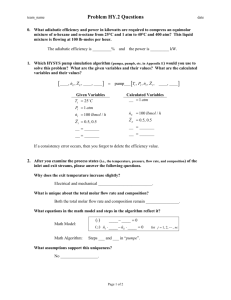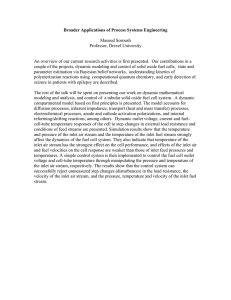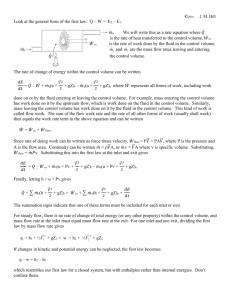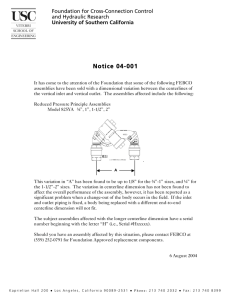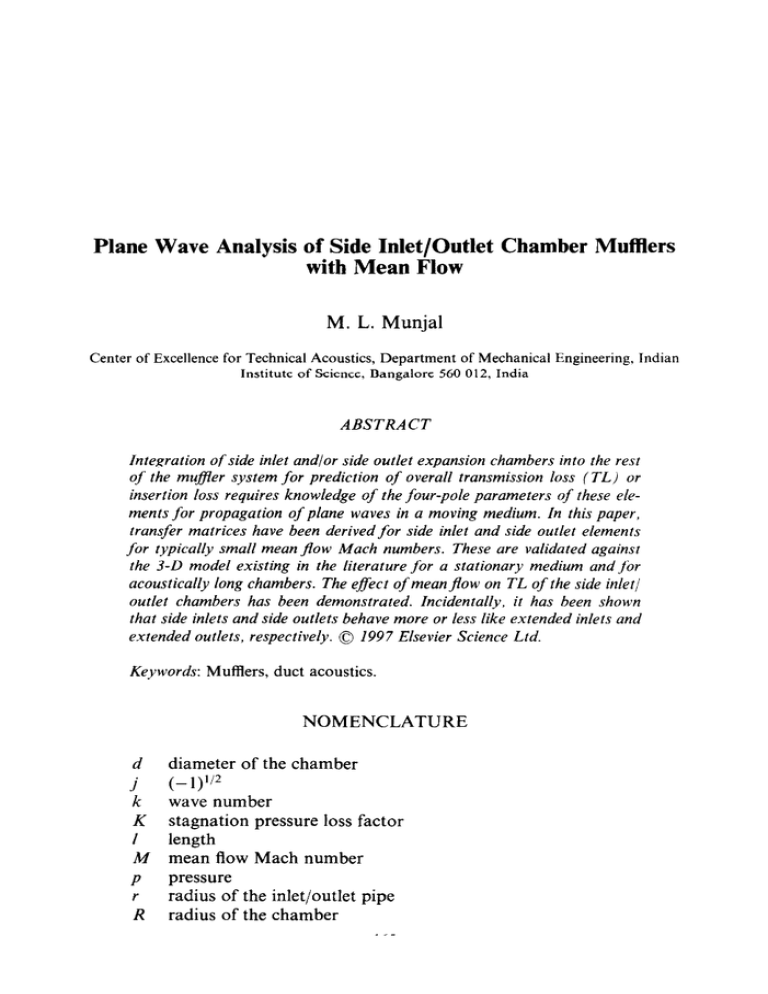
PII:
Applied Acoustics, Vol. 52, No. 2, pp. 165. 175, 1997
Q 1997 Elsevier Science Ltd. All rights reserved
Printed in Great Britain
0003-682X/97 $17.00 + 0.00
SOOO3-682X(96)00053-9
ELSEVIER
TECHNICAL NOTE
Plane Wave Analysis of Side Inlet/Outlet Chamber Mufflers
with Mean Flow
M. L. Munjal
Center of Excellence
for Technical Acoustics, Department
of Mechanical
Institute of Science, Bangalore 560 012, India
Engineering,
Indian
ABSTRACT
Integration of side inlet and/or side outlet expansion chambers into the rest
of the mufier system for prediction of overall transmission loss (TL) or
insertion loss requires knowledge of the four-pole parameters of these elements for propagation of plane waves in a moving medium. In this paper,
transfer matrices have been derived for side inlet and side outlet elements
for typically small mean flow Mach numbers. These are validated against
the 3-D model existing in the literature for a stationary medium and for
acoustically long chambers. The e#ect of mean flow on TL of the side inlet/
outlet chambers has been demonstrated. Incidentally, it has been shown
that side inlets and side outlets behave more or less like extended inlets and
extended outlets, respectively. 0 1997 Elsevier Science Ltd.
Keywords: Mufflers, duct acoustics.
NOMENCLATURE
d
j
k
K
I
M
P
r
R
diameter of the chamber
(- 1)“2
wave number
stagnation pressure loss factor
length
mean flow Mach number
pressure
radius of the inlet/outlet pipe
radius of the chamber
S
V
Y
Z
area of cross-section
velocity
characteristic impedance
impedence
Subscripts
a
b
c
d
e
0
u
left hand side cavity
right hand side cavity
convective (variable); contraction
downstream
expansion
ambient medium
upstream
INTRODUCTION
Most mufflers have their inlet and outlet at the ends, with their axes parallel
to that of the circular chamber. Analysis of these mufflers has been dealt with
at length by the author’ among others. Sometimes however, for logistical
reasons, the inlet and/or outlet are provided on the sides with their axes
normal to the axis of the muffler chamber or shell, as shown in Fig. 1. End
inlets or outlets being parallel to the axis of the chamber may also be called
axial inlets or outlets. Axial inlets or outlets need not be co-axial with the
chambers; an offset is often necessary or desirable.*-’ Believing that threedimensional effects (higher-order modes) would dominate in the case of side
inlet/outlet chambers, Yi and Lee4v5presented a three-dimensional analysis
of such chambers for a stationary medium. Derivation of the four-pole
parameters by means of their 3-D analytical technique is of general application, but may be time-consuming and cumbersome. Besides, the convective
as well as dissipative effects of mean flow have been ignored in their analysis.
For most engineering applications, noise is limited to low and medium frequencies where plane waves would dominate. Therefore, it is desirable to
derive four-pole parameters for side inlet/outlet chambers considering pure
plane waves and incompressible mean flow. This is what is attempted in the
present Technical Note.
By making use of the equations of mass continuity, stagnation pressure
loss and the end resonator impedance, transfer matrices have been derived
here for typically low mean flow Mach numbers (M* << 1), for a side inlet
junction and side outlet junction. These are then used to predict transmission
loss (TL) for two configurations from Refs 3 and 4, for ready comparison at low
and medium frequencies where plane waves are expected to predominate.
168
Technical Note
The effect of mean flow on TL has been shown separately. Finally, it has
been indicated that side inlet/outlet chambers behave more or less like
extended inlet/outlet chambers, and therefore may be designed accordingly.
TRANSFER
MATRIX
FOR SIDE INLET EXPANSION
ELEMENT
Let u, d and a denote upstream point, downstream point and the end-cavity
resonator, respectively, in Fig. 2. These correspond to points 3, 1 and 2 in the
corresponding extended inlet element shown in Fig. 2.13 of Ref. 1. Neglecting M* with respect to unity, the stagnation pressure eqn ((3.81)) of Ref. 1
yields
Pc,u = Pc.d + &Md
&
ydVc,d,
= [(Sd/&)
-
I]*
I
I
(a)
_
-
ald
* --y _ _---_-+
I
_
_
_
_
_
I
I
”
(b)
Fig. 2. Schematics
- -
-----,__+++x-------
for derivation
of transfer
‘a
matrices;
(a) side inlet and (b) side outlet.
(1)
169
Technical Note
and the mass continuity eqn (3.89) of Ref. 1 gives
Vc,u = vc,d +
(2)
Va
where the convective state variables pc and v, at any point in a duct are
related to the classical state variables p and v (at the same point) as’
(3)
or conversely as
[:I=[-l+-‘;“][::I
(4)
where A4 and Y are the mean flow Mach number and characteristic impedance, respectively, and M2 has been neglected with respect to unity.
It may be noted here that the loss factor K, in eqn (1) is for sudden
expansion. In its current form, it is based on axial inlet and exit flow alignment and assumes reattachment of fluid to the bounding surfaces. It does not
consider a change in the direction of flow, as in the case of a side inlet, and
therefore is approximate at best.
For the end cavity closed at the other end by a rigid end plate, eqns (3.94)
and (3.95) of Ref. 1 give
pa/v,
=
z, = -jYacot(k,l,)
(5)
It may be observed from Fig. 2(a) that
(6)
Pa =Pd
Equations (l))(6) may be seen to readily yield the transfer matrix relation
1[
PGU
VC,U
=
1
KeMdyd
1
$-
(1
-
I[ 1
pc,d
y
vC,d
Y
(7)
The corresponding transfer matrix relation in terms of the classical state
variables can be obtained readily from eqns (3) (4) and (7):
_
[I [
pu
VU
-
lM
-2
Yt,
-Mlyu
1
f
f?Y@][&
";'"][y]
(8)
I[
-53
170
Technical Note
Successive multiplication of the three matrices in eqn (8) and neglecting
terms of the order of M2 with respect to unity, yields
l-y
(l+K,)MdYd-M,Y,
-!-
1
Z,
pd
I[
“d
1
(9)
A sudden area discontinuity is analogous to a lumped inductive (inertive)
impedance. Over the years, this impedance has been calculated by means of a
three-dimensional analysis for co-axial discontinuities for stationary medium* and moving medium9 and, more recently, for offset inlet/outlet’ for
stationary medium, valid for frequencies right up to the cut-on frequencies of
the first higher order mode. Peat9 found that the effect of mean flow on both
the real and imaginary parts of the discontinuity impedance is practically
negligible. Discontinuities of the types shown in Fig. 2 have not been analysed so far for prediction of inertance due to evanescent higher order modes
generated at the junction. However, its geometry is somewhat similar to a
circular piston in an infinite baffle. Therefore, heuristically, adding lumped
inertance due to 3-D effects for a piston in an infinite baffle at the first-row
second-column location as in the transfer matrix of a lumped inline impedance,’ gives the required transfer matrix:
1- v
1
Z0
TRANSFER
MATRIX
1
(1 + &)MdYd - M, Y, + Y&0.85&r,)
FOR THE SIDE OUTLET
ELEMENT
1
CONTRACTION
Equations (2)-( 5) would hold for the side-outlet contraction element (Fig. 2b)
as well, except that the stagnation pressure loss factor would be given by
It may be noted here that k, suffers from the same limitation as k,, as
remarked earlier following eqn (4). It has also been used for want of a more
pertinent expression in the published literature.
Equation (6) is replaced by the equation (see Fig. 2b):
Pu = Pa
(12)
171
Technical Note
These equations lead to the following transfer matrix relation in terms of the
convective state variables:
Pc,u
VC,U
K&-fd
1
1
L
Z
-
yd
y
ICI
pc,d
(13)
vC,d
The corresponding relationship in terms of the acoustic state variables may
be obtained by means of the transformation eqns (3) and (4) as in eqn (8).
Neglecting terms of the order of M* with respect to unity, and again noting
that
Md
Mu
--_--
one obtains
1 -y
(14)
yu
yd
Z l-t““z I[ 1 (15)
(Kc+
l)Mdyd--Muyu
M Y -M,Y,
a
1
pd
vd
Finally, from heuristic reasoning as for the side inlet, adding inertive impedance due to 3-D effects at the first-row second-column location, one obtains
the desired transfer matrix:
1- y
(& + l)Mdyd - kf, Y,, +@.85k,rd) Y,
1
Zl
l+
RESULTS
(16)
M,j Yd- h’f, Y,
za
1
AND DISCUSSION
Combining transfer matrices (10) and (16) for side inlets and side outlets,
respectively, with those of other elements like uniform tubes, transmission
loss can easily be calculated’ by means of an existing general user-friendly
program in FORTRAN on a PC486 machine. For corroboration of the
plane wave model with the 3-D model predictions and experimental observations of Yi and Lee,4,5 TL was computed for the following configurations
for a stationary medium.
Side inlet end outlet chamber (Fig. la):
I= 0.3m,
R = O.O61m,
1, = O.l5m,
R/r = 5
(17)
Technical Note
172
Side inlet side outlet chamber (Fig. lc):
I = 0.3m,
R = O.O61m, 1, = O.l5m,
It, = O.O75m, R/r = 5
(18)
Figure 3 compares predictions of the present 1-D model with those of the Yi
and Lee’s 3-D model4 for the side-inlet side-outlet configuration of Fig. lc
with the outlet rotated 1r/2 radians with respect to the inlet, so as to avoid
tunnelling of higher order modes. It may be noted that the plane wave model
predictions are quite satisfactory for this acoustically long chamber
(Z/d = 2.46, d z 2R). The same may be noticed from Fig. 4 for the side-inlet
end-outlet configuration of Fig. la, where Yi and Lee’s 3-D model predictions and experimental observations5 are compared with the present 1-D
model predictions. However, for the acoustically short chambers (1 -C2d),
3-D effects (higher order modes) may be very strong and then the plane wave
model presented here may lead to significant errors, particularly if the
angular disposition of the outlet permits tunnelling of higher order modes.2,6
Incidentally, side inlet behaves quite like an extended inlet and side outlet
behaves like an extended outlet, as shown in Fig. 5. Their TL values are
compared in Fig. 6 for the side-inlet side-outlet configuration of Fig. lc with
1
0
2
Frequency &Hz)
Fig. 3. Comparison
of the present
I-D model with Yi and Lee’s 3-D model
side-outlet chamber.
for a side-inlet
Technical Note
- - -
3-D model
Frequency &Hz)
Fig. 4. Comparison
of the present 1-D model with Yi and Lee’s 3-D model and experimental
measurements for a side-inlet end-outlet chamber.
(a)
I(b)
-~______-___
I
Fig. 5. Functional
I4
--+A
I____
I
equivalence
;__--
I
I
I
of (a) side-inlet side-outlet chamber and (b) extended-inlet
extended-outlet chamber.
Technical
174
0
Note
2
I
Frequency &Hz)
Fig. 6. Comparison
of a side inlet/outlet
chamber with the corresponding
let chamber.
extended
inlet/out-
dimensions as in eqn (18) above and the mean flow Mach number in the
pipe, M = 0.1. The conceptual similarity may be seen to be reflected very
well in the computed TL spectra as well.
It has been observed that the effect of mean flow on TL of the same sideinlet side-outlet configuration is minimal ( i 2 dB) for typical Mach numbers
(A4 = O.l), and therefore has not been shown in this Technical Note. It
indicates that the stationary-medium 3-D model of Yi and Lee4 may be used
for moving medium as well with minimal errors.
CONCLUSIONS
The plane wave model presented here for side inlet/outlet chamber is much
simpler and faster than the corresponding 3-D mode1.4,5 Besides, it incorporates the effect of mean flow, although the same has now been found to be
practically negligible. Incidentally, it is shown that a side inlet behaves like
an extended inlet and a side outlet behaves like an extended outlet. However,
the 1-D model would work only for acoustically long chambers (1224 and
for those angular dispositions of the outlet (with respect to the inlet) that do
not allow tunnelling of higher order modes.*q6 This should be kept in mind
while designing mufflers for medium and higher frequencies.
Technical Note
175
ACKNOWLEDGEMENT
The author is grateful to the Department of Science and Technology of the
Government of India for funding the Center of Excellence for Technical
Acoustics, thereby enabling the research work reported here.
REFERENCES
1. Munjal, M. L., Acoustics of Ducts and Mufleers. John Wiley, New York, 1987.
2. Eriksson, L. J., Higher-order mode effects in circular ducts and expansion
chambers. Journal of the Acoustical Society of America, 1980, 68, 545-550.
3. Ih, J.-G. and Lee, B.-H., Analysis of higher order mode effects in the circular
expansion chamber with mean flow. Journal of the Acoustical Society of America, 1985, 77, 1377-1388.
4. Yi, S. I. and Lee, B. H., Three dimensional acoustic analysis
sion chambers with a side inlet and side outlet. Journal of the
of America, 1986, 79, 1299-1306.
5. Yi, S. I. and Lee, B. H., Three dimensional acoustic analysis
sion chambers with a side inlet and end outlet. Journal qf the
of America, 1987, 81, 1279-1287.
of circular expanAcoustical Societrs
of circular expanAcoustical Societ?,
6. Sahasrabudhe, A. D., Munjal, M. L. and Ramu, S. A., Design of expansion
chamber mufflers incorporating 3-D effects. Noise Control Engineering Journal,
1992, 38, 27-38.
7. Sahasrabudhe, A. D., Munjal, M. L. and Ramu, S. A., Analysis of inertance
due to the higher order mode effects in a sudden area discontinuity. Journal of
Sound and Vibration, 1995, 185, 5 15-529.
8. Kergomard, J. and Garcia, A., Simple discontinuities in acoustic wave guides at
low frequencies: Critical analysis and formulae. Journal qf Sound and Vibration,
1987, 114, 467479.
9. Peat, K. S., The acoustical impedance at discontinuities of ducts in the presence
of a mean flow. Journal of Sound and Vibration, 1988, 127, 123-132.


